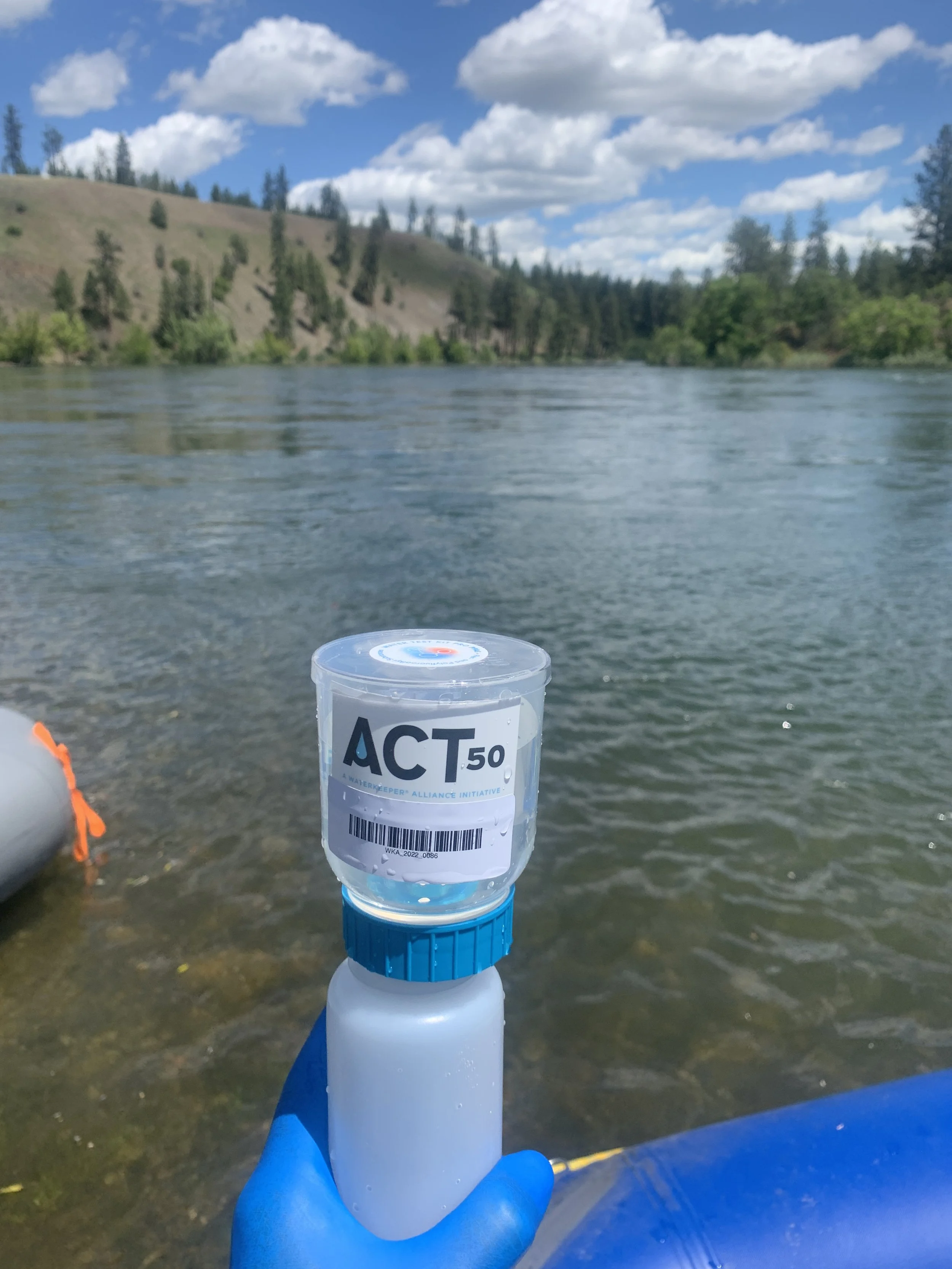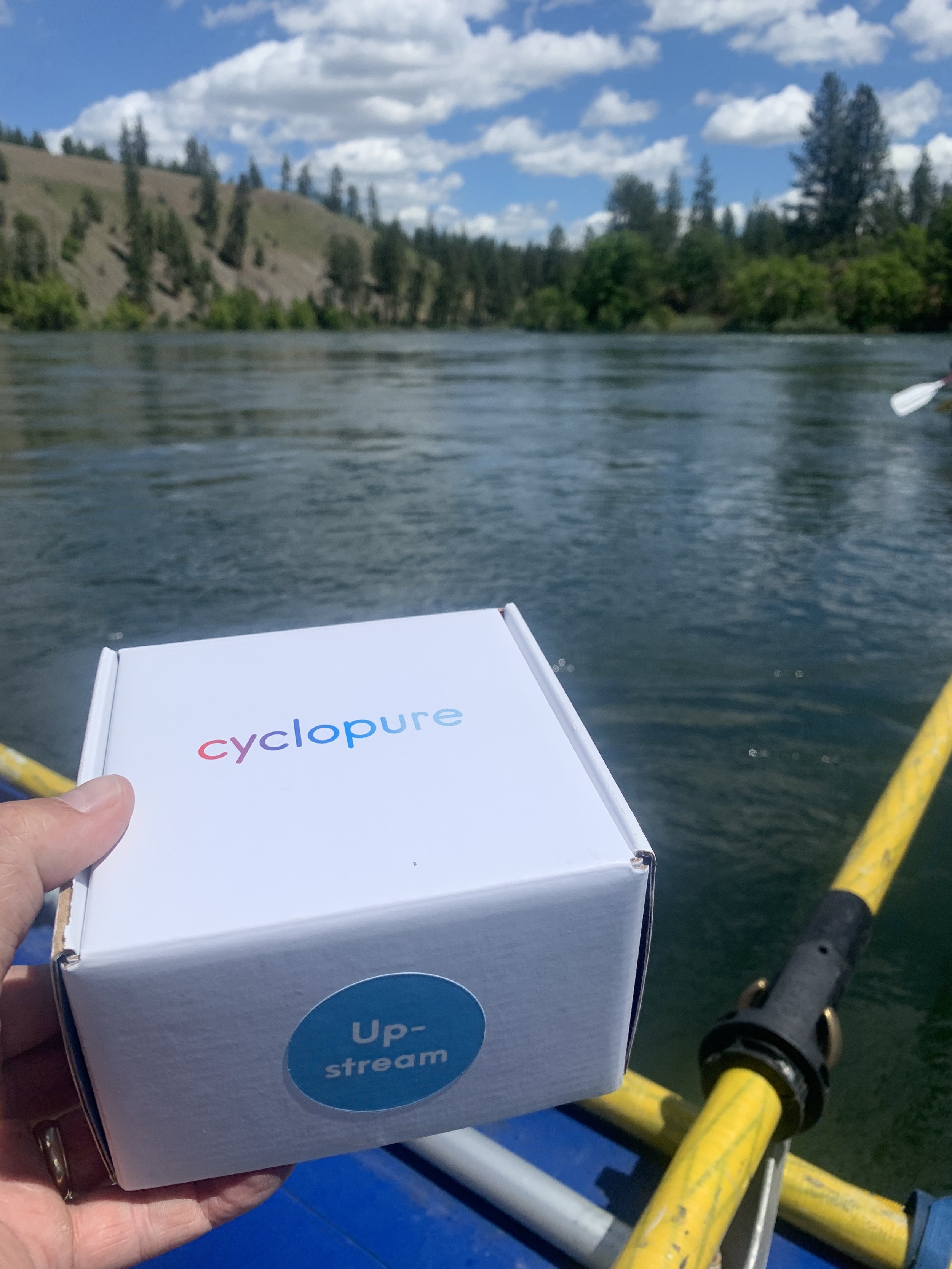Unprecedented National Analysis Reveals PFAS Contamination in the Spokane River
First-of-its kind study by Waterkeeper Alliance found 83% of the waters tested across the country were contaminated by dangerous PFAS chemicals. The Spokane River was also found to have PFAS pollution below Spokane’s Wastewater discharge plant
Sampling was simple. Our intern Maddy shows us how to do it.
Today, Waterkeeper Alliance released a groundbreaking new analysis of American waterways that sound the alarm on a PFAS pollution emergency. In a test of 114 waterways from across the country, 83% were found to contain at least one type of PFAS—dangerous per- and polyfluoroalkyl substances that are widely linked to serious public health and environmental impacts. Spokane Riverkeeper collected samples in the Spokane River, downstream of the Spokane Riverside Park Reclamation Facility (Waste Water Treatment Plant at Riverside - Permit WA0024473). The Spokane Riverkeeper collected samples the above and below the Waste Water Treatment Plant (WWTP) outfall where pollution is discharged to the waters of the Spokane River.
From the Spokane River water samples collected on June 22nd, 2022, two compounds of the PFAS chemical group were found, PFHxA (Perfluorohexanoic acid) and PFOA (Perfluorooctanoic acid). PFHxA was detected at levels of 1.6 parts per trillion (ppt) immediately downstream of the WWTP discharge but was non-detectable (<1 ppt) upstream of the discharge. PFOA was detected at 1.7 ppt at the WWTP discharge and was also non-detectable upstream of it. Riverkeeper Program Lead Jule Schultz stated, “Our results identified the more common PFAS chemicals found in surface waters across the US.”
After sampling and filtering, the sample was boxed for shipment.
Executive Director, Jerry White, Jr. is concerned about the findings. These findings support that the WWTP is the source of PFAS in this location. “It is alarming that we are seeing the presence of PFAS in our river exactly below the Waste Water pollution discharges”. White said, “It seems to confirm that these treatment plants are indeed a contributing source of this pollutant”.
This is highly significant as WWTPs are understood nationally as a common source of this “forever” chemical pollutant. Many types of PFAS do not break down in the environment but persist to cause illness for years. It has long been suspected that PFAS is commonly in the waste water effluent, and this set of samples appears to confirm its presence in waste water being dumped in the Spokane River by at least one discharger. The limited nature of Spokane Riverkeeper sampling cannot show how much of this toxic chemical is in the effluent, but it does confirm the need for required monitoring. In the early months of 2022 when several large municipal waste water permits were open, the Spokane Riverkeeper specifically asked that the pollution permit for the Spokane WWTP to require monitoring for the PFAS family of chemicals. This request was denied in the final permit that was issued. In their response to public requests for pollution permits to include wastewater monitoring for PFAS, Washington Department of Ecology (WDOE) responded:
“Ecology will not be requiring PFAS (and related chemicals) monitoring in this permit. However, because PFAS in Spokane drinking water supplies would be a source to wastewater treatment plants, we will track the situation and evaluate next steps should PFAS be discovered in the Spokane public water systems or EPA issues a drinking water standard for PFAS.”
WDOE effectively disregarded the concern for PFAS in surface waters of the Spokane River, and the new and emerging concerns that wastewater is a pathway for these toxic chemicals.
WDOE should understand the effects of waste water pollution on the Spokane River, understand the contributions of PFAS from treated waste water pollution. Pollution permits should require that dischargers provide legal, publicly accessible data by which the public can understand what kinds of PFAS we are allowing to be dumped into our river.
In his statement on the findings, Jerry White, Jr, Spokane Riverkeeper stated “It seems bizarre that we are not requiring pollution dischargers to monitor and report the nature of their discharge of PFAS into the Spokane River. We know that across the country attention is only growing and that the federal EPA is paying a great deal of attention to this class of toxic chemical pollution. We are disappointed that our own Department of Ecology did not include the requirement for monitoring in the pollution permits”.
The Spokane Riverkeeper calls for the community to be able to understand which of those dischargers, and NPDES permittees, are polluting the Spokane River with PFAS, understand the magnitude of that pollution, the types of PFAS, and the pathways of that pollution.
Spokane Riverkeeper is asking WDOE to mandate pollution dischargers to test wastewater and the receiving waters (Spokane River) for this family of chemicals. This will allow the State to develop the methods to protect our Spokane River, its ecosystems, and the public from this awful “forever” chemical pollution.”
***
Background on National testing effort and the results by Waterkeepers:
A total of 113 local Waterkeepers, including the Spokane Riverkeeper collected samples from 114 waterways across 34 states and the District of Columbia (D.C.). Independent analysis indicates a shocking level of contamination, with 94 participating Waterkeeper groups confirming the presence of PFAS in their waterways. Waterways in 29 states and D.C. were found to be contaminated by at least one, but most frequently, many revealed the presence of up to 35 different PFAS compounds.
“When we began testing waterways for PFAS earlier this year, we knew that our country had a significant PFAS problem, but these findings confirm that was an understatement. This is a widespread public health and environmental crisis that must be addressed immediately by Congress and the U.S. Environmental Protection Agency (EPA). To begin tackling this urgent problem, Congress should start by passing the Clean Water Standards for PFAS Act of 2022, and EPA must prioritize using the funding from the Bipartisan Infrastructure Law to coordinate national monitoring and adopt regulatory standards for PFAS contamination. This report provides the information necessary for federal and state governments to take action and protect the health and safety of our communities,” said Marc Yaggi, CEO of Waterkeeper Alliance.
In some places, like creeks connected to the Potomac River in Maryland, the Lower Susquehanna River in Pennsylvania, and the Niagara River in New York, the level of contamination is thousands to hundreds of thousands of times higher than what experts say is safe for drinking water. This is of particular concern as an estimated 65% of Americans source their drinking water from surface waters similar to those sampled.
These findings are an important step toward filling in a major data gap and validate the Alliance’s call to EPA for increased and widespread monitoring to gain a complete picture of PFAS contamination in all watersheds across the country.
Since at least the 1950s, PFAS have been widely used in manufacturing and are found in many consumer, commercial, and industrial products. Often referred to as “forever chemicals,” PFAS do not break down over time. Instead, these dangerous chemicals accumulate in people, wildlife, and the environment. As a result, PFAS have been found in surface water, air, soil, food, and many commercial materials. Scientific studies increasingly link these toxic chemicals to serious health conditions such as cancer, liver and kidney disease, reproductive issues, immunodeficiencies, and hormonal disruptions.
Despite serious health risks, there are currently no universal, science-based limits on the various PFAS chemicals in the United States. For many PFAS chemicals, the EPA has not even set a health advisory limit that would give the public a baseline to determine what amount of PFAS is unhealthy in drinking water. In most cases, the EPA is not doing adequate monitoring for these chemicals, which is why these findings are so unique and important. The Washington Department of Ecology should be requiring this monitoring in Spokane River Waters and waste water as well as waterways nationally.
This data plainly demonstrates that Congress and EPA must act with urgency to control persistent PFAS contamination across the country. The current lack of oversight puts the health and safety of communities and ecosystems across the nation at risk and results in costly cleanup and treatment activities to remove PFAS contamination after it has occurred. To learn more, visit waterkeeper.org/pfas.



